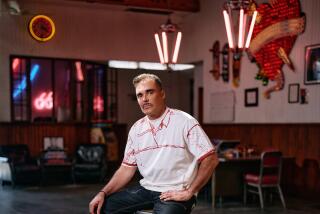With ‘#Sandy,’ photographers phone it in
Last October, as Hurricane Sandy was approaching the Eastern Seaboard, photographer Benjamin Lowy, on assignment for Time magazine, ventured out to Coney Island to capture the swells coming in from the surge. A man had waded into the crashing waves, almost as if on a dare. Lowy, who’s been embedded in Iraq, Libya and Afghanistan, didn’t hesitate to charge into the stormy waters to get closer. Bringing an unwieldy DSLR (digital single-lens reflex camera) into the ocean was out of the question, so he grabbed his iPhone and got the shot.
Lowy was one of many professionals who used an iPhone to cover the events of the storm that racked up nearly $65 billion in damages.
“Using iPhones allowed us to spread the news quicker by uploading images immediately to Instagram, which connected to Twitter, Facebook and our websites,” said Wyatt Gallery, who photographed the aftermaths of Hurricane Katrina and the 2010 Haiti earthquake.
ART: Can you guess the high price?
Gallery spearheaded the publication of the upcoming book “# Sandy” (Daylight Books), featuring 100 iPhone photos by photographers of the superstorm and its aftermath.
“We were able to create a more complete view of one incident from 20 different perspectives,” he said of the idea to publish a collection of photos for a book after an impromptu gallery show last November.
A few days after Sandy hit, friends Gallery, Lowy and Ruddy Roye were driving home from a day of shooting the destruction at Rockaway Beach in Queens.
“I knew we were going to have a great collection of photos between the three of us and thought we could have an exhibition to sell the photos and raise money to help,” Wyatt said. His shot of a lowly home, lifted off its base and tossed in a marsh, was taken on Kissam Avenue in Staten Island, one of the worst-hit areas.
CRITICS’ PICKS: What to watch, where to go, what to eat
Searching # Sandy on Instagram, Gallery contacted other photographers who also snapped images with their iPhones. Three weeks later, a one-night exhibition at the Foley Gallery in New York City showcased 100 images by 20 veteran photographers, including Ed Kashi, Giles Clarke and Hank Willis Thomas, who lost nearly all his artwork that was stored in a gallery in Chelsea. The event raised $19,000, which was donated to Occupy Sandy and Third Wave Volunteers.
All the royalties from the sale of the books will go to Occupy Sandy for continued rebuilding in the area.
Gallery recently returned to 92nd Street in the Rockaways, where he took many of his images a year ago.
CHEAT SHEET: Fall arts preview
“It looked amazing. New trees were planted, homes had been fixed up,” he said. “But inside, the homes are a wreck. Some still need gutting from mold and others need walls. They are just waiting on insurance, FEMA and aid.”
“#Sandy” also includes survivors’ firsthand testimonials of rescues and good Samaritans.
Lowy, the first to take the indelible image of the Jet Star roller coaster in Seaside Heights, N.J., recalled an encounter with a man named John Lennon: “He was an older gentleman who lived in Roxbury across from Breezy Point. His basement had flooded and his house was fine but he was still bemoaning: ‘One day after all this and I’m still getting prank calls asking me where Ringo is!’”
A selection of images from the book are on view at the exhibition “Rising Waters: Photographs of Sandy,” at The Museum of the City of New York through March 2.
More to Read
The biggest entertainment stories
Get our big stories about Hollywood, film, television, music, arts, culture and more right in your inbox as soon as they publish.
You may occasionally receive promotional content from the Los Angeles Times.










